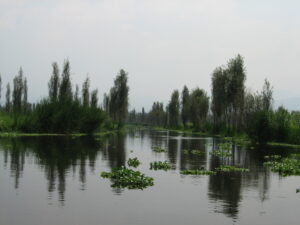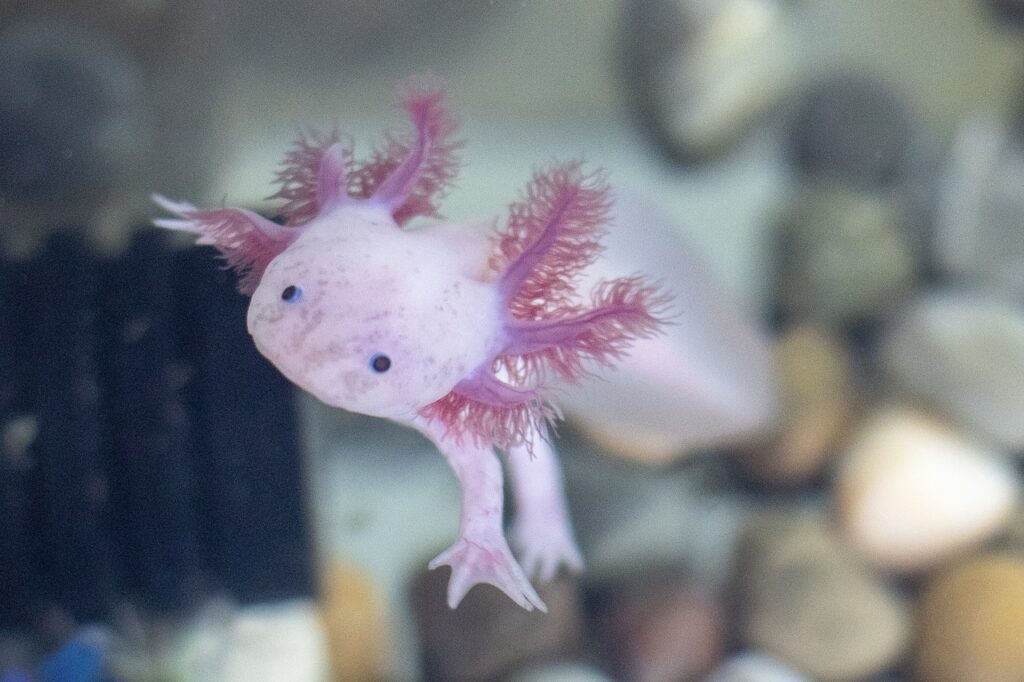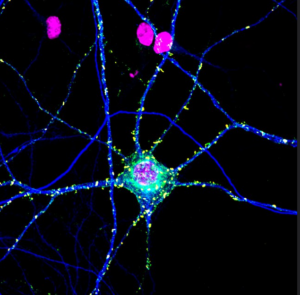Known for its pale pink body and Mona Lisa-like smile, the Mexican axolotl (Ambystoma mexicanum) is a figure of intrigue. Affectionately nicknamed “water monsters”, axolotls are eerie creatures that have burrowed their way into the hearts of many people.1 Their protruding frill-like gills and lidless eyes have been known to captivate and repulse people alike, but their mutant-like ability to perfectly regenerate limbs can be accredited to their rise to fame, both in history and in contemporary times (See Figure 1).
Axolotls first gained recognition during the time of the Aztecs. While building their city Tenotchtitlan in modern-day Mexico City, the Aztecs cooperated with the natural wetlands and canals, shaping them to facilitate the growth of their city while still maintaining their natural features. Axolotls thrived during these times, and featured prominently in Aztec myths. One of the most notable legends is that of Xolotl, the god of fire and lighting, as well as the god of sickness and deformities, and how he chose to transform himself into an axolotl to escape being sacrificed by the other gods. Although his endeavor failed and he ultimately perished, the axolotl was named in his honor.2 Today, the axolotls are most famous for their unique quality of regenerating their tissues. They can grow back limbs, organs, spinal cords, and even parts of their brains without a single trace of scarring. This ability makes them incredibly valuable in the world of medical research. Discovering what aspects of their biology grants them this miracle would lead to significant leaps in human medicine. 3

Wild axolotl populations began to be monitored in the 1990s. They had decreased from 6,000 individuals per square kilometer in 1998 to 100 individuals per square kilometer in 2008.6 This number then dropped to 35 individuals per square kilometer in 2015. This drastic reduction in wild axolotls is concerning, especially considering they are an endemic species, meaning they can only be naturally found in one spot in the world. In the decades since these revelations, three main threats to axolotl populations have been identified: the urbanization of their natural habitat, the decline of water quality, and the introduction of exotic, predatory fish.7
The axolotl’s native habitat is the wetlands of Xochimilco in Mexico City, an area of about 40 square kilometers. It consists of canals interwoven among chinampas, small rectangular island-like pieces of land traditionally used to grow crops by farmers (See Figure 2). These chinampas formed part of the traditional Aztec style of farming, and the axolotl coexisted alongside them. However, in the centuries after the fall of the Aztec empire, these aquatic habitats began to be dismissed in favor of more contemporary styles of farming and urbanization.8 The wetlands were drained of their water and replaced with buildings and roads. Previously home to wild axolotls, Lake Chalco in Mexico City was drained completely to expand the city and assuage worries of flooding among citizens.9

Today, agricultural runoff from the chinampas and nearby farms, which includes pesticides and fertilizer, inundates these wetlands, creating a eutrophic environment. Eutrophic means that the environment is so nutrient-heavy that plant growth is overwhelming and absorbs all the oxygen, suffocating native animal species like the axolotl.12 As if this weren’t enough, pollution from Mexico City often also enters the wetlands. Overflows from the sewage system are common and they can be catastrophic to the animal populations in Xochimilco, particularly the axolotl. Heavy metals, ammonia, oils, and other toxins common in runoff from urban areas can penetrate their permeable skin and cause significant damage as exposure grows. 13
Axolotl eggs and young are particularly vulnerable, as their development is negatively impacted by these toxins. The contamination in the water has been found to lead to methemoglobinemia, a condition that lowers the activity levels of the axolotls and interferes with their natural behaviors. Pollution obstructs their sense of smell, thereby interfering with their hunting habits. Although deformities in axolotls have not occurred yet, researchers believe that if contamination rates continue, it might only be a matter of time until deformities are documented.14
Not only have the urbanization and decrease in water quality affected the axolotls, but invasive fish species have been introduced to these wetlands, displacing the role of the axolotls in their ecosystem. Nile tilapia (Oreochromis niloticus) and common carp (Cyprinus carpio) were initially introduced into Xochimilco to provide more fishing opportunities, but competition with the axolotl soon led to trouble. These invasive fish species devour the eggs, larvae, and juveniles of axolotls. Not satisfied with merely eating axolotls, they also compete with them when hunting for prey. Studies have found that axolotls catch less prey in the presence of tilapia and carp due to the competition, as well as the fact they spend valuable energy avoiding the path of these predators. The presence of these fishes has not only affected the number of axolotl individuals but also their size and growth rate, since their dietary habits have been disrupted.15

- “Mexico City’s ‘water Monster’ Nears Extinction.” 2008. NBC News. November 2, 2008. https://www.nbcnews.com/id/wbna27503150. ↵
- Voss, S. Randal, M. Ryan Woodcock, and Luiz Zambrano. 2015. “A Tale of Two Axolotls.” BioScience 65 (12): 1134-40. doi:10.1093/biosci/biv153. ↵
- “Axolotl | National Geographic.” 2010. Animals. October 9, 2010. https://www.nationalgeographic.com/animals/amphibians/facts/axolotl. ↵
- Дарья, Уткина. 2014. Русский: Аксолотль- Неотеническая Личинка Некоторых Видов Амбистом, Земноводных Из Семейства Амбистомовых. Own work. https://commons.wikimedia.org/wiki/File:%D0%90%D0%BA%D1%81%D0%BE%D0%BB%D0%BE%D1%82%D0%BB%D1%8C_%D0%BC%D0%B5%D0%BA%D1%81%D0%B8%D0%BA%D0%B0%D0%BD%D1%81%D0%BA%D0%BE%D0%B9_%D0%B0%D0%BC%D0%B1%D0%B8%D1%81%D1%82%D0%BE%D0%BC%D1%8B_%28Ambystoma_mexicanum%29.jpg. ↵
- “Ambystoma Mexicanum (Axolotl).” n.d. Accessed February 28, 2023. https://www.iucnredlist.org/species/1095/53947343. ↵
- Alcaraz, Guillermina, Xarini López-Portela, and Cecilia Robles-Mendoza. 2015. “Response of a Native Endangered Axolotl, Ambystoma Mexicanum (Amphibia), to Exotic Fish Predator.” Hydrobiologia 753 (1): 73–80. https://doi.org/10.1007/s10750-015-2194-4. ↵
- Voss, S. Randal, M. Ryan Woodcock, and Luiz Zambrano. 2015. “A Tale of Two Axolotls.” BioScience 65 (12): 1134-40. doi:10.1093/biosci/biv153. ↵
- Voss, S. Randal, M. Ryan Woodcock, and Luiz Zambrano. 2015. “A Tale of Two Axolotls.” BioScience 65 (12): 1134-40. doi:10.1093/biosci/biv153. ↵
- “Mexico City’s ‘water Monster’ Nears Extinction.” 2008. NBC News. November 2, 2008. https://www.nbcnews.com/id/wbna27503150. ↵
- Simon, Gael. 2006. English: Canals in Xochimilco Français: Canaux à Xochimilco Español: Canales En Xochimilco Brezhoneg: Kanoloù e Xochimilco. Own work. https://commons.wikimedia.org/wiki/File:Chinampas_Xochimilco.jpg. ↵
- Voss, S. Randal, M. Ryan Woodcock, and Luiz Zambrano. 2015. “A Tale of Two Axolotls.” BioScience 65 (12): 1134-40. doi:10.1093/biosci/biv153. ↵
- Magazine, Smithsonian. n.d. “How to Save the Paradoxical Axolotl.” Smithsonian Magazine. Accessed March 28, 2023. https://www.smithsonianmag.com/science-nature/saving-paradoxical-axolotl-180967734/. ↵
- Fessl, Sophie. 2018. “The Race to Save the Axolotl.” JSTOR Daily. April 25, 2018. https://daily.jstor.org/the-race-to-save-the-axolotl/. ↵
- Chaparro-Herrera, Diego de Jesus, Sarma Nandini, and S. S. S. Sarma. 2013. “Effect of Water Quality on the Feeding Ecology of Axolotl Ambystoma Mexicanum.” Journal of Limnology 72 (3): e46–e46. https://doi.org/10.4081/jlimnol.2013.e46. ↵
- Alcaraz, Guillermina, Xarini López-Portela, and Cecilia Robles-Mendoza. 2015. “Response of a Native Endangered Axolotl, Ambystoma Mexicanum (Amphibia), to Exotic Fish Predator.” Hydrobiologia 753 (1): 73–80. https://doi.org/10.1007/s10750-015-2194-4. ↵
- LaDameBucolique. 2017. English: Axolotl 🙂. https://pixabay.com/photos/axolotl-leucistique-male-ambystoma-2193331/. https://commons.wikimedia.org/wiki/File:Axolotl-2193331_1280.webp. ↵
- Voss, S. Randal, M. Ryan Woodcock, and Luiz Zambrano. 2015. “A Tale of Two Axolotls.” BioScience 65 (12): 1134-40. doi:10.1093/biosci/biv153. ↵




23 comments
Samantha Maygers
Hello! This is a very interesting article, and it’s very cool that these little creatures can be leveraged for research purposes as well! Do you keep axolotls through their life span, or are they only helpful in research through a certain point in their lives?
Illeana Molina
This is such a well-written article and I loved the imagery/colors and layout of the overall piece. I am happy to be learning something new and the pictures help. I think its important to keep native species like the Axolotl’s alive and to be able to spread awareness of our world/ecostystem that we often do ignore. Thank you for writing this article on a unique creature and how it affects our population. Great job Bianca !!
Aaron Astudillo
Wanted to say congratulations on being recognized for a possible nomination. Furthermore, thank you for writing an article on such a cute creature and shining a light on its history and impact within the environment. Additionally, being able to talk about the impact that pollution has on its population.
Vincent Villanueva
First off Bianca congratulations for being recognized as this article is exceptionally structured and well thought out. I believe this article is important and crucial to many different species that need proper recognition. As mentioned in the article, the axolotl which serves to be relevant to our everyday lives as I myself learned more about this topic by reading this article.
Gabriella Parra
Bianca! Congratulations on your nomination! I enjoyed learning about the history of the axolotl. I had noticed its popularity recently, but I didn’t know much about them at all. It’s amazing that they have a long history of importance and that they are useful today in medical research. The conservation of any animal is very important, so it’s great that you chose to write about this topic!
D'vaughn Duran
Congratulations on being nominative! This article is very cool and interesting regarding the history of axolotls. Axolotls seem very interesting and you give the reader background information. Which the information does great on! This reading was so well put together with this topic. I always found axolotls very interesting and cute. I enjoyed reading this article and the title is great.
Abbey Stiffler
The only thing I really knew about axolotls was how they looked because my friend had one. It is upsetting to learn that the axolotl’s natural habitat is in the wetlands of Xochimilico in Mexico City and how drastically habitat degradation rates are rising. The water became contaminated and unsafe for axolotls and other invasive species, which reduced their populations. It’s encouraging to hear that experts and regular people are battling for the axolotls’ safety and survival.
Carolina Wieman
First of all congratulations on your nomination! this article is very informative and sheds light on a topic I was not aware of. I never would have thought that axolotls were an endangered species non the less that we have a major part in harming their habitats. Having unregulated rules about waste can cause major issues, especially for species that are more sensitive to waste. I think that if we are more self-aware and make sure that we put in place rules to further protect our special species.
Bryon Haynes
Congratulations on the nomination! I loved getting to learn so much about axolotls because I’ve only ever seen them in fictional settings and they’re rarely ever talked about even discussions of animals arise. Getting to learn their scientific names and how they have adapted to live as a species was definitely the highlight of the article.
Luke Rodriguez
This was a fantastic read! Also, congrats on the nomination! It was well-deserved. The article was well-written and detailed. I had seen pictures of Axolotls before but never knew their name or history. It’s crazy how rare where they come from was that you could only find them producing there. It sounds devastating that the wetlands had to be trained for building and streets to be built.